The Prinias of Eastern Arabia: Graceful (P. gracilis) vs Delicate (P. lepida) – a Taxonomic Tangle
Guest blog by Gregory Askew
The Graceful Prinia (Prinia gracilis) is a small, brownish, long-tailed warbler of damp habits in otherwise arid environments, including in and around anthropogenic sites. Where it occurs, it’s often quite abundant—nigh ubiquitous. Owing to this, birders have often paid little mind to this tiny brown bird beyond simply noting its presence.
However, the announcement in 2021 that Graceful Prinia sensu lato is, in fact, two distinct species—Graceful (P. gracilis) and Delicate Prinia (P. lepida)—has meant that birders in the Middle East have reason to pay closer attention to the prinias they are encountering. This is especially true in eastern Arabia, where both species are now known to occur, as well as possibly northwestern Levant (Alstrom & Rasmussen 2022).
The authors of the paper on which the split was based—Alstrom et al—made this recommendation on the basis of genetic, morphological, and vocal differences. According to the paper, Graceful Prinia sensu stricto occupies roughly the southwestern half of the former range, including the Central and Eastern regions of Saudi Arabia, while Delicate Prinia occupies roughly the northeastern half, including Kuwait, the UAE, and northern Oman (Alstrom et al 2021). The close proximity of Delicate Prinia to eastern Saudi, a region, like the rest of the country, that has been significantly under-studied, held out the promise that both species actually might occur there. Indeed, a figure (fig. 1) from the paper presenting the distribution of the taxa for both species shows the locally endemic subspecies of Graceful (P. g. hufufae) in eastern Saudi and Bahrain, sandwiched as it were, between P. l. irakensis to the north and P. l. carpenteri to the southeast (Alstrom et al 2021). P. g. hufufae is provisionally included with Graceful Prinia on the basis of morphological comparisons, lacking the genetic and acoustic sampling necessary for confirmation. The status of the prinias in Qatar, however, is not discussed. This lack of data on the prinia taxa occurring in eastern Arabia has left a golden opportunity for local birders to help fill some of the gaps in their study.
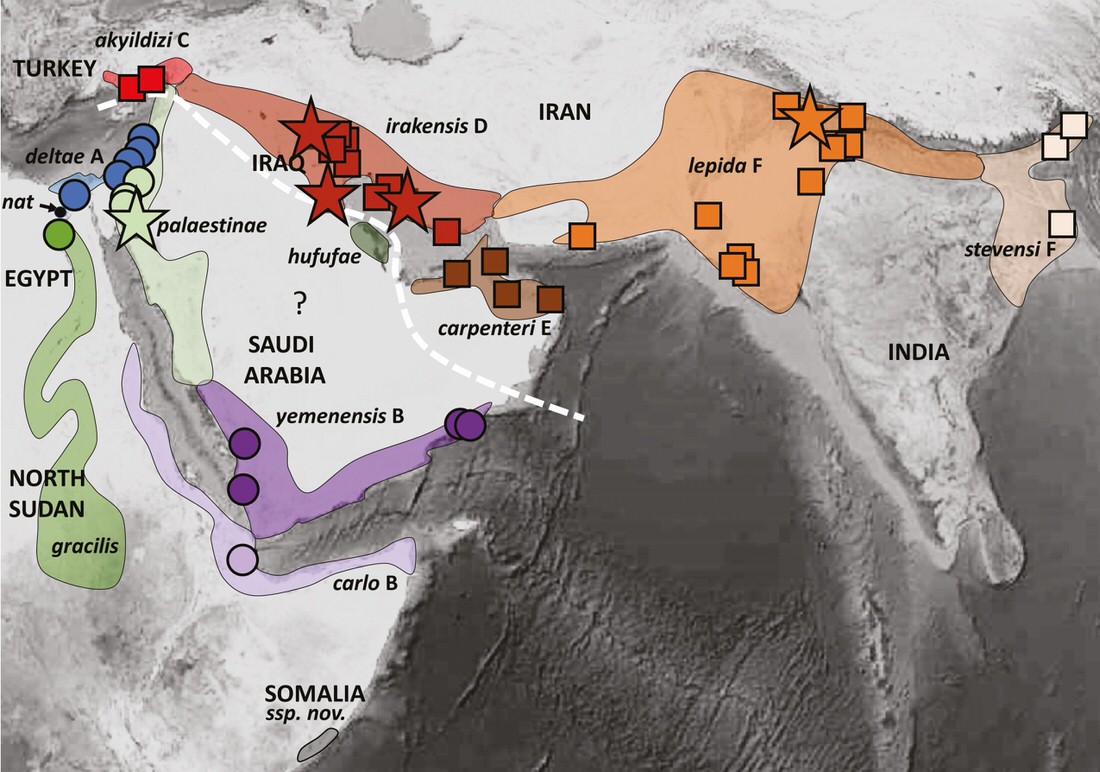
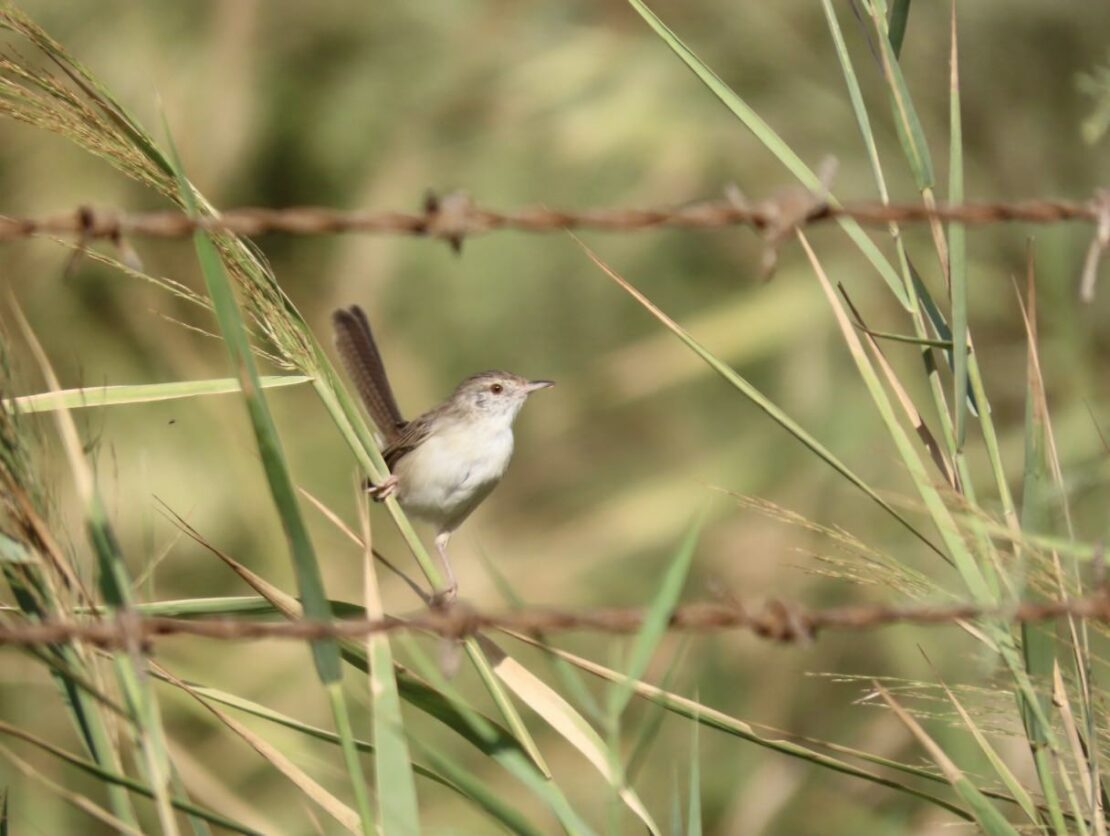
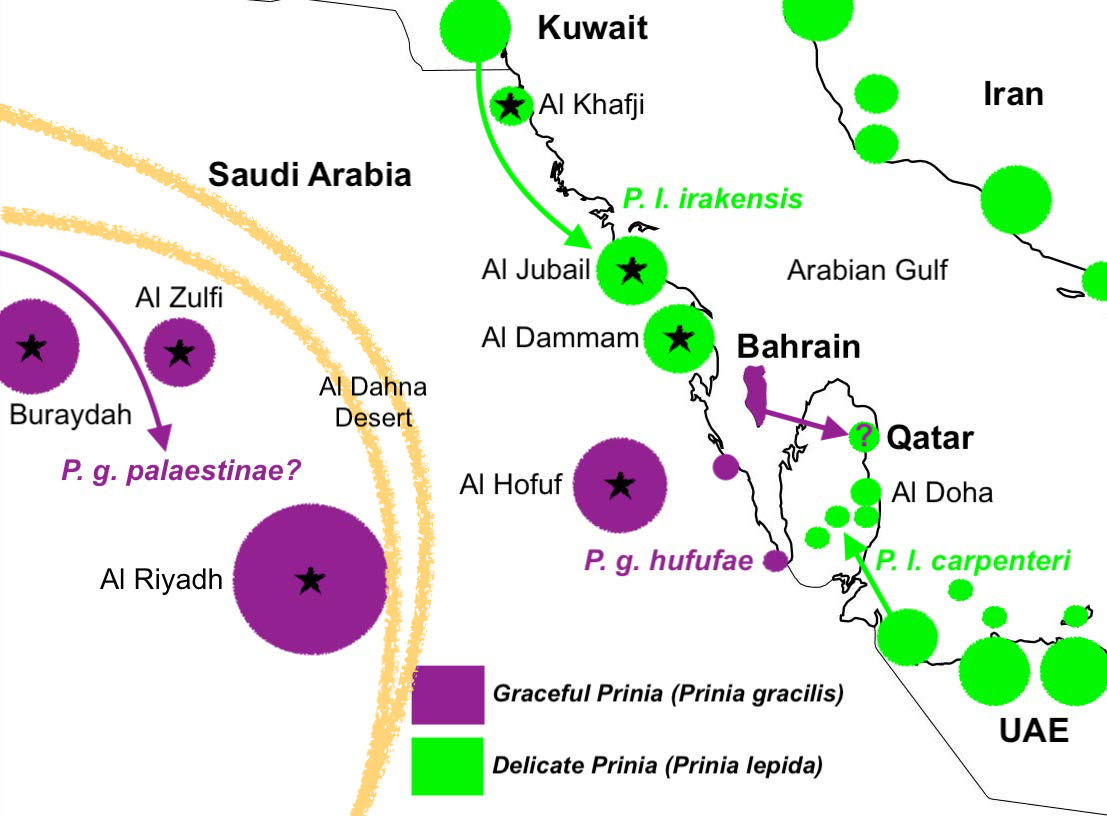
Upon reading of the split, the open question on the prinias in eastern Saudi fired up my interest in these quintessential little brown jobs in a way that stood in stark contrast with how much I previously took them for granted. All of sudden, they became a mini birding obsession. During summer 2021, I gathered images and audio to confirm that the birds found around Al Ahsa are indeed Graceful Prinia, which Alstrom et al left as tentative, based on key features in appearance and voice (Askew 2021). Then I directed my energy to whether Delicate Prinia had crossed into Saudi from Kuwait and the UAE, initially traveling to the northern border town of Al Khafji, where I documented P. l. irakensis (fig. 2) in the fringing vegetation at the local wastewater treatment plant (Askew 2021). Since then other birders and I have confirmed that P. l. irakensis has, in fact, colonized virtually the whole of northeastern Saudi, with birds documented from around Jubail (Babbington 2021), the farms and wetlands of Al Qatif (Askew 2022), and as far south as Dhahran (Babbington per comm; Manwaring 2023).
In the past year, we have also confirmed that Delicate, P. lepida carpenteri,has colonized eastern and south-central Qatar (Andrews 2022), strengthening the possibility that that particular taxon, having spread westward out of the UAE, also occurs in Saudi near the border towns of Batha and Salwa. Further, birders in Qatar have long believed that P. gracilis hufufae also occurs in the small Gulf country, but this has only just been confirmed through a recording of a singing male from a suspected population in mangroves near Al Khor (Hollister 2022). Interestingly, the rate of delivery is similar to that of the Bahrain population, which I also documented prior to leaving the Middle East (Askew 2022), suggesting the possible provenance of the Qatari population. This is further bolstered by a 1998 record from the Hawar Islands of Bahrain, which lie just offshore the western shore of Qatar (Jennings 2010), assuming that the taxon was indeed P. g. hufufae and not P. l. carpenteri.The map below (fig. 3) presents what we believe to be the current known distribution of Graceful and Delicate Prinia in Northeastern Arabia based on the photographic and acoustic evidence eBirders have gathered over the past year and a half.
Getting to our current understanding has been made all the more challenging owing to how similar these two species are in voice and appearance and thus easily confused. What follows is an identification guide to help birders in Eastern Arabia separate the two according to key morphological and acoustic features.
MORPHOLOGICAL DIFFERENCES
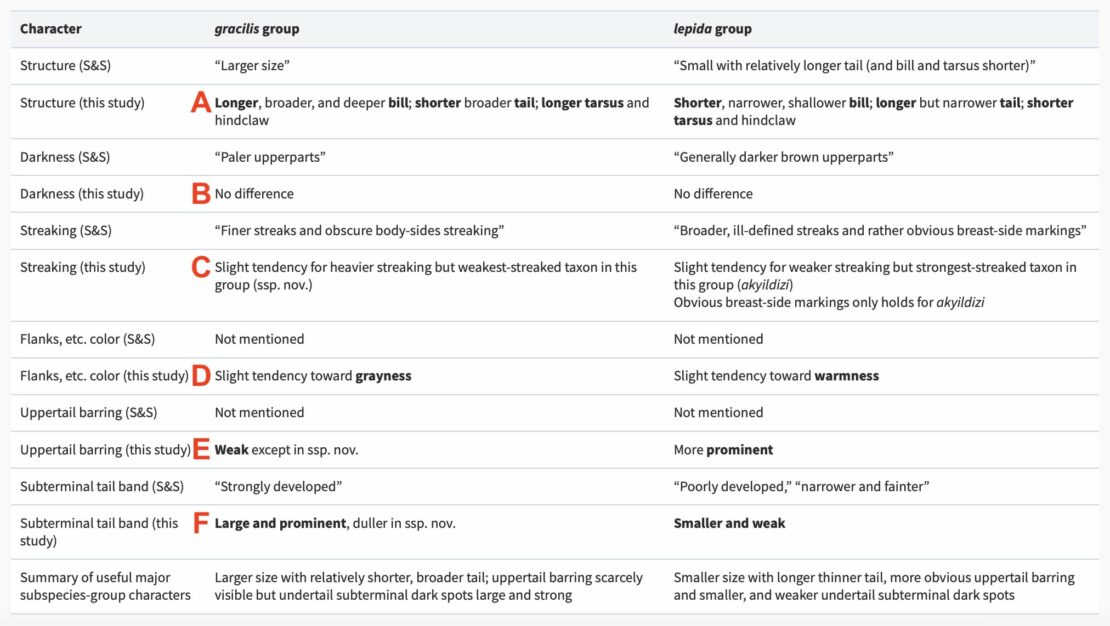
The Alstrom paper includes the table above (fig. 4), which conveniently distills the key morphological differences between Graceful and Delicate, the most prominent and reliable of which are shown in boldface (Alstrom et al 2021). Most structural features (A) are difficult to judge under typical field conditions, with the exception, perhaps, of the length and shape of the tail. As for the streaking on the upperparts (C), this difference is subtle but Graceful (hufufae) in Eastern Arabia does appear to show heavier streaking on the crown, mantle, and wing coverts than either P. l. irakensis or P. l. carpenteri. Flank coloring (D), on the other hand, is perhaps too slight and variable to be useful in the field. Delicate tends to show a warmer tone, but I photographed Gracefuls in the Al Ahsa region showing a similarly warm wash to the lower flanks. As for the relative darkness of each species’ coloration (B), this varies between subspecies within each species group. While Alstrom et al cite no difference between Graceful and Delicate in this regard, Shirihai and Svensson (2018) indicate that former shows paler upperparts than the latter. In Eastern Arabia, this appears to only be true for P. l. irakensis. P. l. carpenteri, which Shirihai and Svensson synonymized with P. g. hufufae, may actually appear lighter in the field—an overall tawny coloration—than the P. g. hufufae that have been photographed around the Al Ahsa region and Bahrain.
Given the difficulty in pinning down the features discussed above as well as the variability of a few, that leaves features D and E as the morphological clinchers. When observing in the field, we need clear views of the upper- and undertail, as determining which species we’ve encountered comes down to scrutinizing bars and bands. I’ll focus on each of these key features in turn, starting with the latter, the most critical for ID.
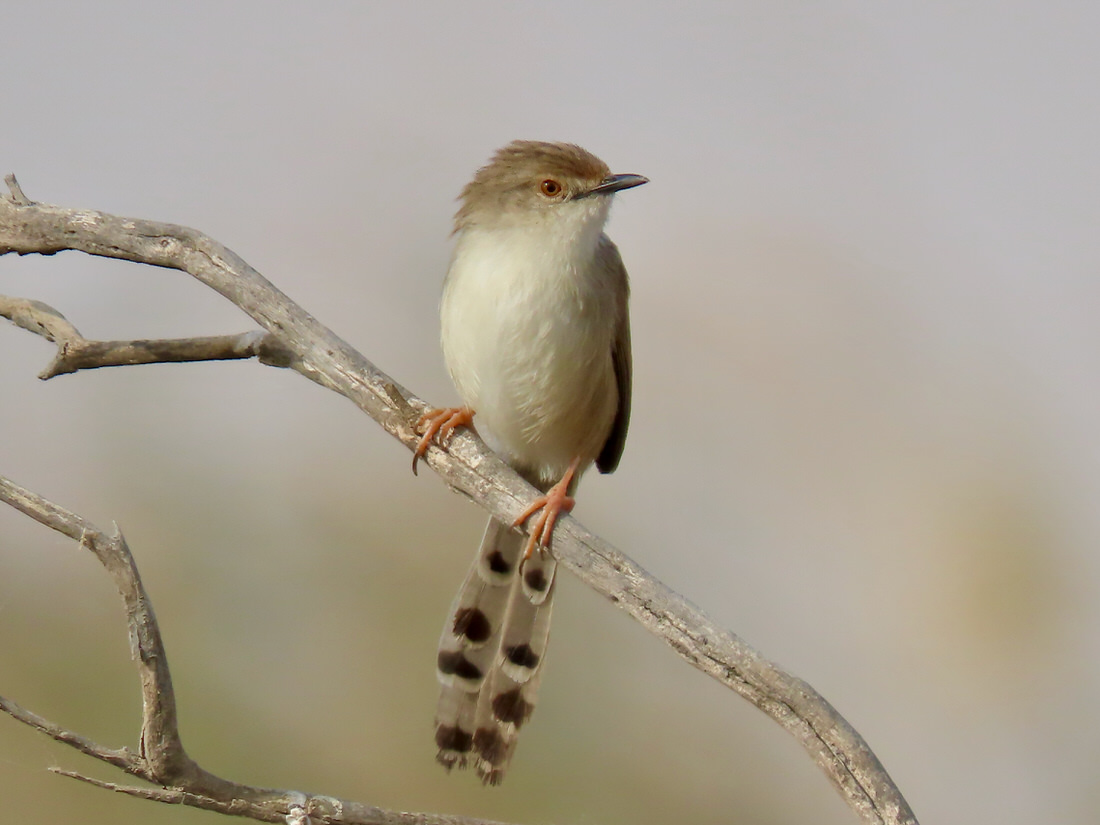
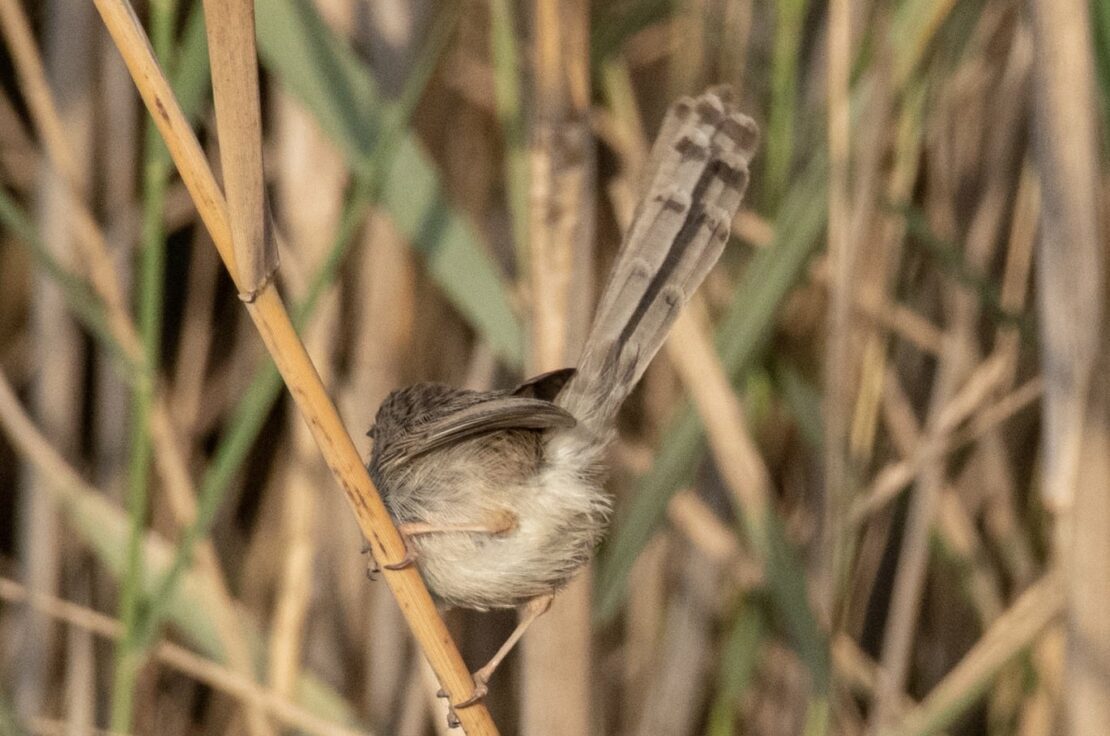
The most important visual feature (E) to pay attention to is the size, shape, and strength of the subterminal bands on the underside of the tail. As noted in the table, these bands on Graceful are larger and more prominent than those found on Delicate, whose tend to be smaller and weaker (Alstrom et al 2021). In addition to the larger size, it should also be noted that there is often a difference in the shape of the subterminal bands found on each, with Graceful having something closer to spots (fig. 5)—more rounded, sometimes heart-shaped—and Delicate having something closer to proper bands, distinctly narrower than those on Graceful (fig. 6). As for the strength of the bands, I don’t believe this is just an effect of the intensity of the color—with Graceful’s bands running darker and more contrasting than Delicate’s—but possibly also a difference in the overall ground color of the undertail feathers. The Graceful I photographed during my last year in Saudi appear to be lighter in color on the undertail than the Delicate, whose bands seem to grade slightly at the edges, making them appear weaker still.
As for the barring on the uppertail, this is a key feature (D) to consider with caution as the Graceful Prinias in Al Ahsa can also show slight barring (fig. 7). This feature is also variable in and between the different taxa of Delicate Prinia with many images in the Macaulay Library of P. l. carpenteri from the UAE showing individuals with barely visible uppertail barring. This variability has made separating Delicate from Graceful in Qatar all the more challenging when views of the subterminal bands were not obtained. Here’s where the length and shape of the tail may help. Delicates have slightly longer and narrower tails, which they fan less frequently. Coupled with distinctly noticeable barring on the uppertail (fig. 8), this would strongly point to Delicate; however, it wouldn’t be enough to confirm the ID in the absence of clear views of the subterminal bands. Depending on light and angle, however, the bands may show through on upper side of the tail feathers, giving at least some impression of the shape and intensity.
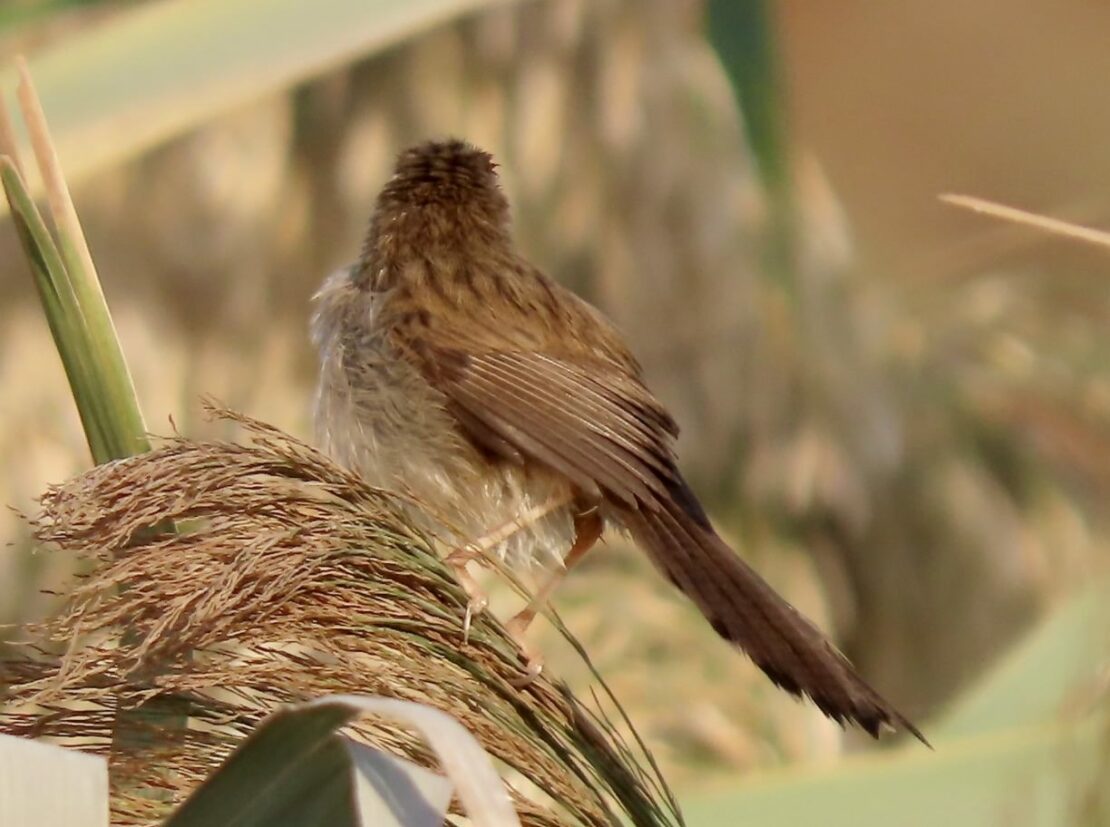
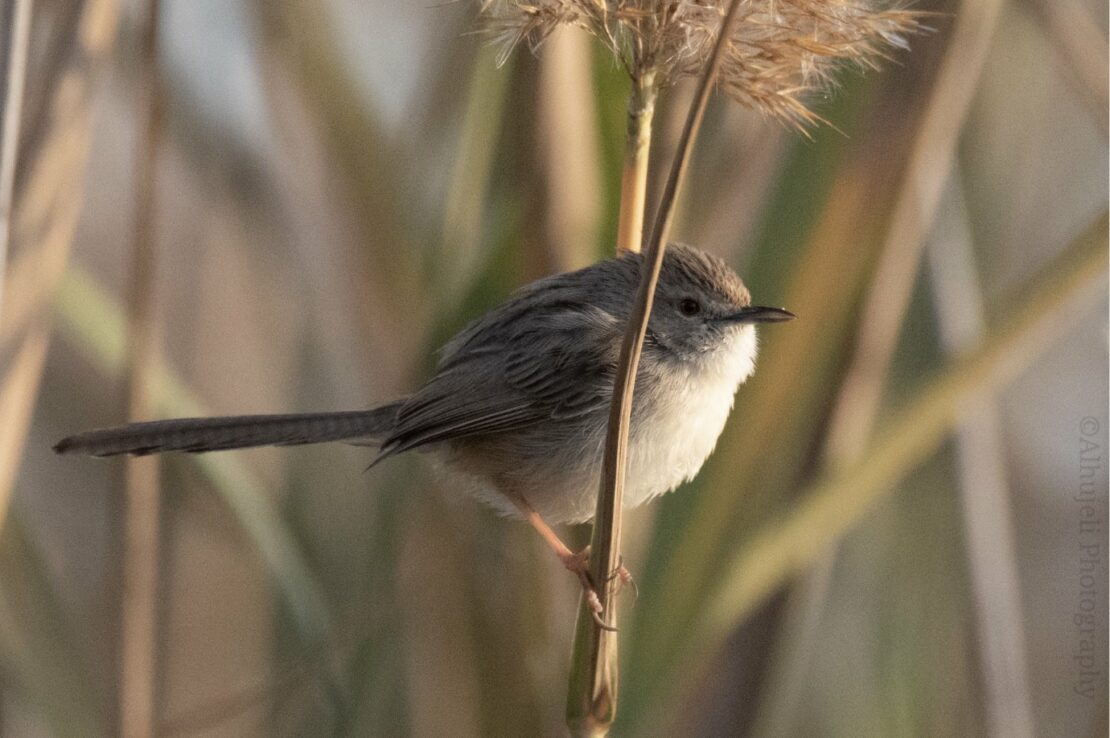
To sum up this key feature, however, uppertail barring on Graceful is often weak and perhaps barely visible, whereas on Delicate it should stand out more obviously. Despite the variability within and between the species, taken in conjunction with the other features, such as GISS and coloration, the uppertail barring can be a good indicator of which species you have found.
Vocal Differences
way of separating the two species in the field. Just looking at the spectrograms featured in the figure below (fig. 9), the key differences are clearly visible—the space between individual phrases, reflecting the rate of the delivery and the length of the buzzy trill at the start of each phrase. The overall impression from Graceful’s song is a steady, rhythmic, if monotonous, delivery at around 3 phrases per second. Delicate’s song, on the other hand, has very short spaces between phrases—4 to 5 per second—and with more buzzy filler, producing a song that sounds like a “continuous grating reel” (Alstrom et al 2021).
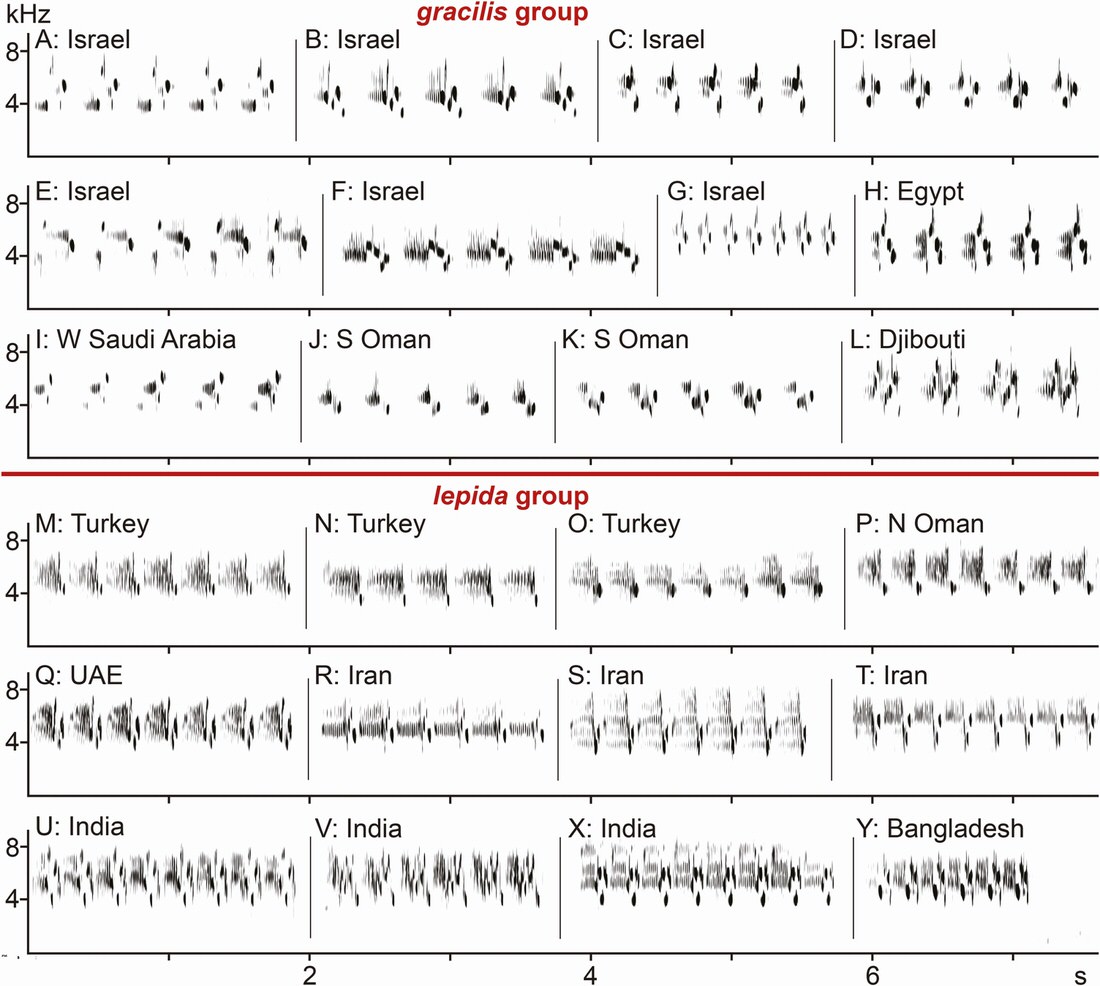
The following spectrograms from the Macaulay Library—one of a Graceful Prinia at Al Asfar Lake in Al Ahsa (fig. 10) and one of a Delicate Prinia from Qatar (fig. 11)—represent what the typical song for each species sounds like—surely not easily confused, right?
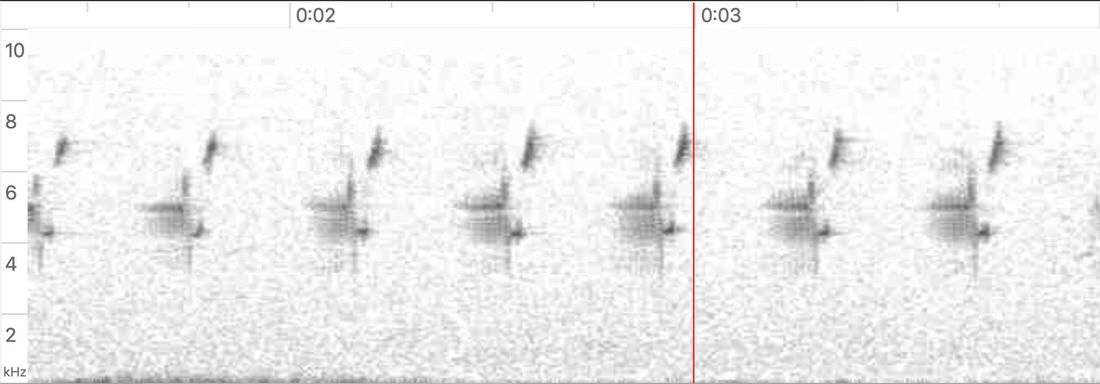

Well, turns out all of the Delicate Prinias I’ve recorded in northeastern Saudi, presumed to be P. l. irakensis, which, according to Mike Jennings, began colonizing Kuwait in the 1990s and continued its advance southward into the Kingdom (Jennings 2010), sing slower than P. l. carpenteri in the UAE and northern Oman. Based on my recordings and those in Xeno-Canto and Macaulay Library from Kuwait, Iraq, and Iran, it appears that P. l. irakensis sings at an average rate of 4 phrases per second, as in the spectrogram below (fig. 12), whereas P. l. carpenteri sings at an average of 5 phrases per second. While still faster than that of the local population of Graceful Prinia, which sing at an average of 3 phrases per second, the difference is even less discernible by ear than I previously thought, especially as I occasionally encountered Graceful Prinias around Al Ahsa singing closer to that rate of delivery. In fact, several of the Gracefuls I recorded in Bahrain averaged closer to 4 phrases per second with one individual from Barbar Farms that registered solidly at that rate while those around him sang slightly slower (fig. 13). For this reason, birders in Eastern Arabia should use caution IDing by ear in the absence of visual confirmation.
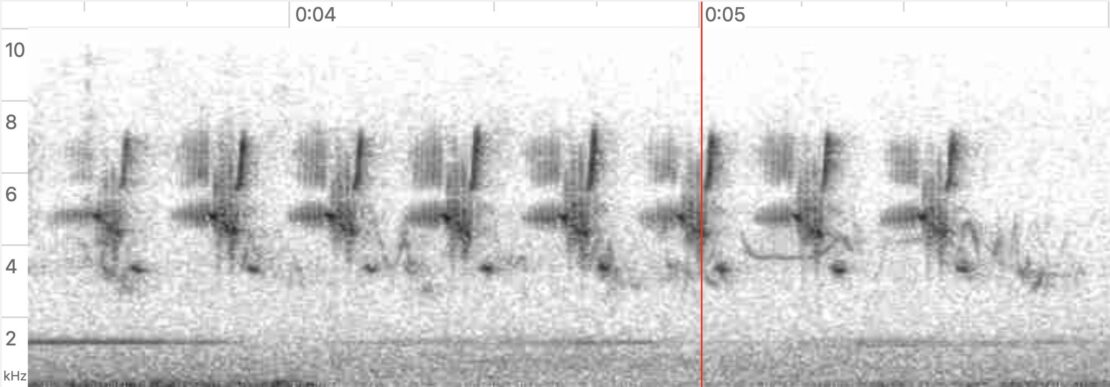
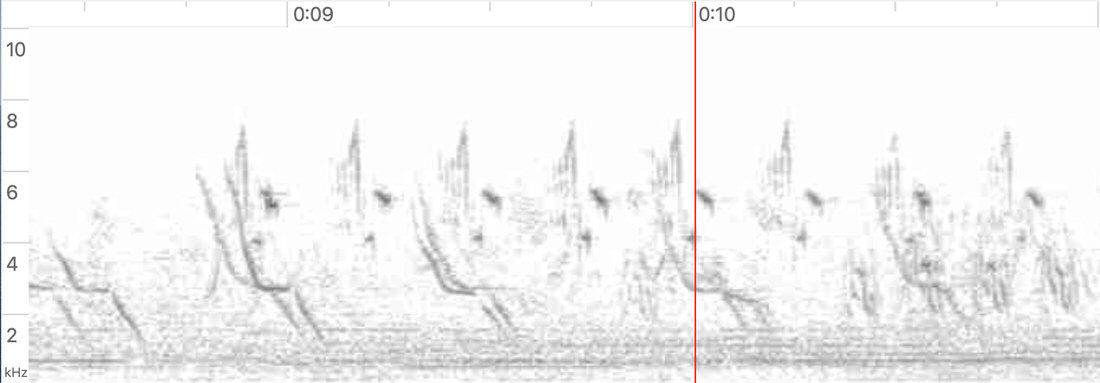
As for the calls, while not discussed in Alstrom et al, there doesn’t appear to be a notable difference. For this reason, contact and alarm calls are not believed to be useful for field identification. Observers should focus their attention on singing males.
Questions Persist
While much has been learned in the past year and a half about the occurrence of Delicate in Saudi, we still don’t know how far P. g. hufufae ranges beyond the Al Ahsa region. There have been no records from Abqaiq and the Modon Industrial Area, both of which lie between Dhahran to the north and Al Ahsa to the south. Jem Babbington, however, has confirmed Graceful in Al Uqair (per comm), a coastal area some 35 kilometers to the east of the nearest population in Al Ahsa and 60 kilometers to the south of Dhahran.
Interestingly, there is a question of whether Graceful occurs around Al Qatif, a large oasis north of Dammam around which extensive farms and date plantations have developed over the years. Historical record indicates that Al Qatif was first settled in 3500 BCE and appears to have been an important agricultural area for much of its history since (2023). Similarly, the Al Ahsa oasis—from which P. g. hufufae, the easternmost and locally endemic subspecies, presumably evolved—has been under virtually constant cultivation since the Bronze Age, some 5000 years ago. While it now appears clear that P. l. irakensis has colonized the region, this may have been a more recent development as, according to Jennings (2010), the taxon only first showed up in Kuwait in the 1990s. However, some photographic evidence from the Al Qatif farms shows prinias with features better for Graceful (fig. 14). In fact, some individuals I encountered during my visit to the area struck me as rather ambiguous, with songs that sounded too slow for Delicate and not quite as buzzy despite displaying key morphological features.
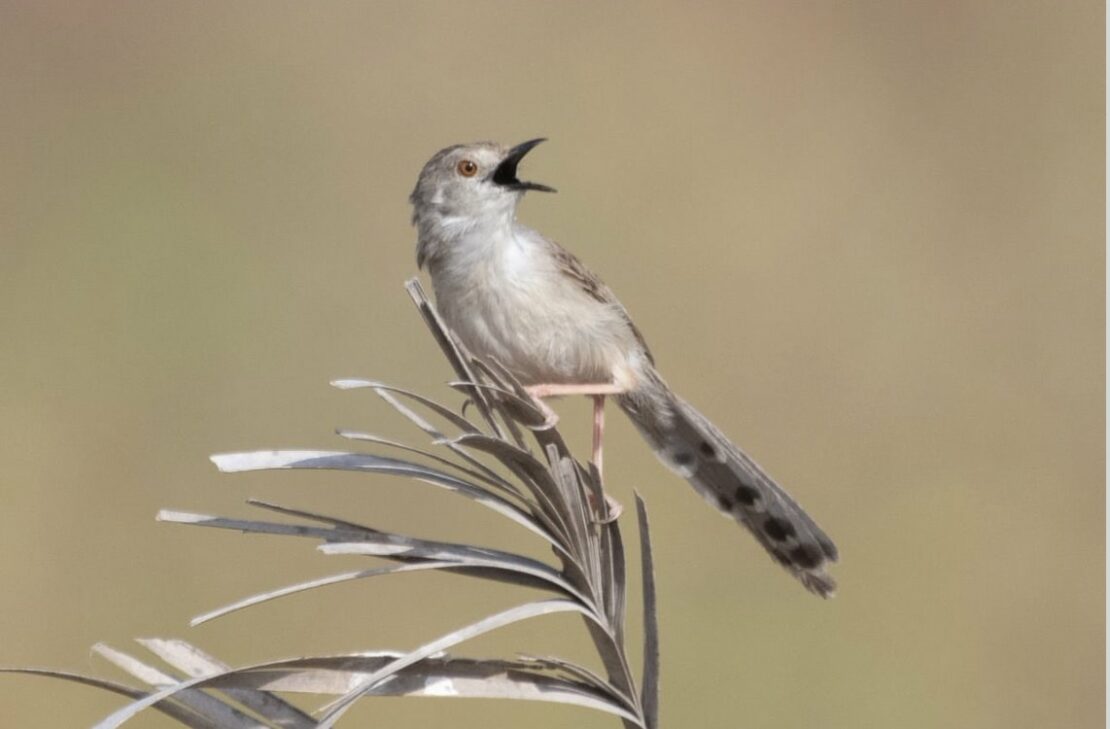
Could P. g. hufufae have been present in the Al Qatif oasis all along and only within recent decades has come in contact with Delicate invading from the north? If so, could we be witnessing from this contact the effect of vocal convergence or even hybridization? Some birders in Qatar have been wondering the same regarding the prinias there. Genetic testing as well as more extensive acoustic sampling and morphological analyses is certainly required. A full account of recent findings will be published in Sandgrouse in due course.
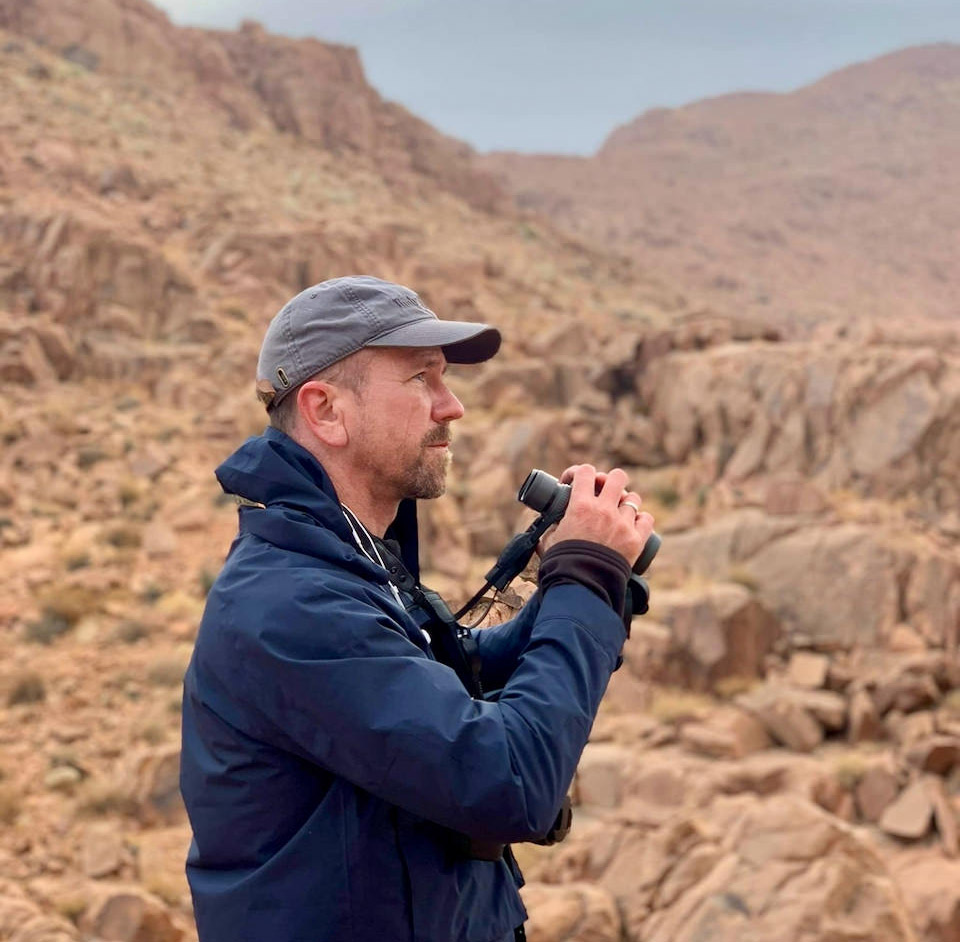
Greg Askew is currently based in Wichita Falls, Texas, where he teaches English to Royal Saudi Air Force cadets at the Sheppard Air Force Base. He continues to keep a finger on the pulse of birding in Saudi Arabia through his role as the regional eBird reviewer and as a bird guide and led the first official bird tour to Saudi in March 2022. He is leading tours there in July and October.
Literature Cited
Al Hujeli, M. 2023. Macaulay Library at the Cornell Lab of Ornithology image
ML531337281. https://macaulaylibrary.org/asset/531337281 (Accessed 25 February 2023)
Al Hujeli, M. 2023. Macaulay Library at the Cornell Lab of Ornithology image
ML538548391. https://macaulaylibrary.org/asset/538548391 (Accessed 25 February 2023)
Al Sheikh, A. 2021. Macaulay Library at the Cornell Lab of Ornithology image
ML530250301. https://macaulaylibrary.org/asset/530250301 (Accessed 11 February 2023)
Alström, P, PC Rasmussen, C Xia, L Zhang, C Liu, J Magnusson, A Shafaeipour, U Olsson, Morphology, vocalizations, and mitochondrial DNA suggest that the Graceful Prinia is two species, Ornithology, Volume 138, Issue 2, 6 April 2021, ukab014
Alström, P and PC Rasmussen. 2022. Delicate Prinia (Prinia lepida), version 1.1. In Birds of the World (B. K. Keeney, Editor). Cornell Lab of Ornithology, Ithaca, NY, USA.
Andrews, K. 2022. eBird Checklist: https://ebird.org/checklist/S107210053. eBird: An online database of bird distribution and abundance [web application]. eBird, Ithaca, New York. Available: http://www.ebird.org. (Accessed 11 February 2023).
Andrews, K. 2022. Macaulay Library at the Cornell Lab of Ornithology sound recording ML438467201. https://macaulaylibrary.org/asset/438467201
Askew, G. 2021. eBird Checklist: https://ebird.org/checklist/S96533912. eBird: An online database of bird distribution and abundance [web application]. eBird, Ithaca, New York. Available: http://www.ebird.org. (Accessed 11 February 2023).
Askew, G. 2021. eBird Checklist: https://ebird.org/checklist/S127354335. eBird: An online database of bird distribution and abundance [web application]. eBird, Ithaca, New York. Available: http://www.ebird.org. (Accessed 11 February 2023).
Askew, G. 2021. Macaulay Library at the Cornell Lab of Ornithology image
ML381656501. https://macaulaylibrary.org/asset/381656501 (Accessed 11 February 2023)
Askew, G. 2021. Macaulay Library at the Cornell Lab of Ornithology image
ML398793321. https://macaulaylibrary.org/asset/398793321 (Accessed 11 February 2023)
Askew, G. 2021. Macaulay Library at the Cornell Lab of Ornithology sound recording ML351657071. https://macaulaylibrary.org/asset/351657071. (Accessed 11 February 2023)
Askew, G. 2022. Macaulay Library at the Cornell Lab of Ornithology sound recording ML403910541. https://macaulaylibrary.org/asset/403910541. (Accessed 11 February 2023)
Askew, G. 2022. Macaulay Library at the Cornell Lab of Ornithology sound recording ML433882501. https://macaulaylibrary.org/asset/433882501. (Accessed 11 February 2023)
Askew, G. 2022. eBird Checklist: https://ebird.org/checklist/S100324006. eBird: An online database of bird distribution and abundance [web application]. eBird, Ithaca, New York. Available: http://www.ebird.org. (Accessed 11 February 2023).
Askew, G. 2022. eBird Checklist: https://ebird.org/checklist/S106443483. eBird: An online database of bird distribution and abundance [web application]. eBird, Ithaca, New York. Available: http://www.ebird.org. (Accessed 11 February 2023).
Hollister, C. 2022. eBird Checklist: https://ebird.org/checklist/S107159971. eBird: An online database of bird distribution and abundance [web application]. eBird, Ithaca, New York. Available: http://www.ebird.org. (Accessed 11 February 2023).
Jennings, MC. 2010. Atlas of the Breeding Birds of Arabia. Fauna of Arabia 25: 537 – 540.
Manwaring, S. 2023. eBird Checklist: https://ebird.org/checklist/S126592206. eBird: An online database of bird distribution and abundance [web application]. eBird, Ithaca, New York. Available: http://www.ebird.org. (Accessed 11 February 2023).
